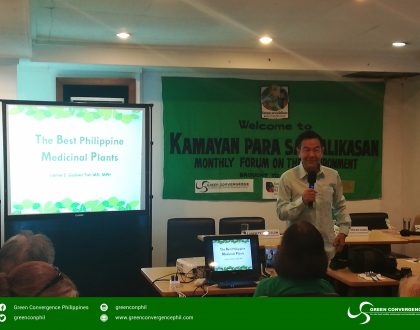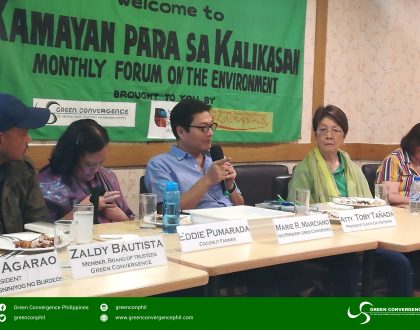Sustainable Economy for the Philippines
Hon. Joey Salceda
Governor, Province of Albay
Good Morning! Unang-una salamat sa pagbibigay ng opportunidad sa akin upang maibahagi at matuto na rin ako sa mga ginagawa ng iba. Siguro naman kung may pipiliin kayong presidente para sa 2016, isa lang ang pamantayan: yung marunong makinig. At tignan ninyo na ang kanilang mga programa ay naka-base sa pakikinig sa mga ordinaryong masa.
Pasasalamatan ko muna po yung mga talagang nagtaguyod sa akin: sa tulong po ng DENR, si Secretary Paje na taga-Guinobatan, Albay; siyempre ang Green Convergence; kasama po ang EMB; pati na po yung Environmental Studies Institute, Dr. Angelina Galang, Tessa Oliva, Marie Marciano, Beth Ceralbo and Vicky Segovia.
Simulan ko na ang aking kwento ng Albay. Alam nyo simple lang ang mensahe ko: “Go local. You’ll never go wrong.” In my experience because I’ve done Congress, I’ve done presidential economic adviser and I’ve done international; I think the best that ever happened to me is working with the people as a local government unit where every day is a transparency and accountability for me.
Ito ang aking kwento. Ito talaga mas ginusto ko na mabuo kaagad. Alam nyo tinamaan kami ng bagyo noong 2006. Kalahati ng ekonomiya ko nawasak. Bilang isang ekonomista, “Paano ko sisimulan itong gawin ulit?” Sabi ko, “Unang-una di ka dapat kabahagi kung bakit nangyari iyon.” So doon talaga nagsimula ang pagiging “green” ng Albay. Mas green ang Albay sapagkat nakita namin na climate change ang dahilan at
kung gusto naming mabuhay, dapat di na kami dadagdag sa problema. Iyon ang simula ng lahat, kung bakit ginawa namin ang ginawa namin.
Ano ba para sa amin ang Albay Green Economy? Ito ay nagnu-nurture ng low emission which basically portrays yung aming commitment to climate change reduction. Inclusive and empowering – walang naiiwan at dapat empowering. Aanhin mo naman yung inclusive na katiting? Kasama ka nga nandoon ka naman sa dulo. Dapat ang ekonomiya ay empowering hindi lang inclusive. Kaya kung ang pamantayan mo sa presidente ay inclusive growth, mali yan. Dapat empowering growth. Empowering ng vulnerable hindi lang yung basta naiwan. Pangatlo dahil nandito lahat ng klase ng hazard katulad ng hazard ng seismic belt, ibig sabihin yung mga bulkan, nandyan ang mga earthquake. Nandoon rin tayo sa ring of fire. Door mat pa kami ng mga bagyo dahil doon nagsisimula sa dulo ng Pasipiko. Bago muna pumasok kahit saan, dadaan muna sa amin. So kailangan di ka magkakaroon ng development – hindi growth ang development kung hindi resilient. Kailangan nakapaloob na sa mga estratehiya ang pagiging resilient.
Ang ibig sabihin, nakahanda kung may mangyari. Mayroon kaagad na gagamitin upang maipanumbalik ang kakayahan ng mga komunidad na ma-sustain ang dignidad ng lahat ng miyembro at siyempre nandoon ang sustainability. Sa amin sa Albay, simple lang. The next generation should have the same means and access to achieve their potential and achieve their goals as a people. So hindi pwedeng ang lahat na ma-achieve ay Milleneum Development Goal (MDG) lamang, which we did. Pero dapat may naiwan pa para sa susunod. Sa pananaw ko mas marami ang iniwan namin para sa susunod na generation.
Simulan natin yung pinaka-simple, iyong capacity to provide ecosystem services. Environment should be an ecosystem that can provide ecosystem services for economic development.
Kung seven years lang ang gagamitin at US satellite imagery, umangat kami ng 88% over the past seven years at ang ginamit namin ay pili, narra at mahogany. Pero tignan ninyo yung cumulative impact ng Urban Development Program, National Greening Program at ng barangay forestry program na doon sinimulan sa Albay, from 6,300 hectares of forests in 2003, we are now 53,074 hectares. Nagtatanim kami ng 10,000 trees.
Halimbawa, last year nagtanim kami ng 3,000 pero ang dinagdag lang namin dyan sa 53,074 hectares ay 507 hectares lang. Inaassume naming 80% mortality sa aming pagtatanim ng kahoy. Ang pagtatanim ng kahoy sa Albay ay kasing ordinaryo ng pagsipilyo. Ganoon kasi ang aming paniniwala. Kung wala kaming environment, paano kami mabubuhay? Hindi ako nagyayabang, sinasabi ko lang na kaya natin. Kaya natin na from 6,300 hectares, iangat sa 53,074 hectares ang forest cover natin. Kasama dito yung mga programang B+WISER and REDD+.
We have 4 major watersheds being managed actively in joint venture with DENR and, of course, various bilaterals including GIZ for REDD+ and USAID for B+WISER.
Tapos yung aming mga mangroves, from only 700 hectares, ngayon nasa may 2,400 hectares kami at mayroon kaming balak na iangat ito ng 1,200 hectares. Wala nang matitirang beach sa Albay, puro na lang mangroves. Pero nandoon ang kakayahan, kaya po may leader. Siya yung nagbabalance nung kailangan ngayon at saka mga kailangan ng susunod. Kaya ako nagkakaganito kasi gusto ko na maintindihan niyo na ang 2016 ay napakakritikal para sa Pilipinas.
Maraming pumapasok na bagyo sa Albay. Pero from only 95,000mt net production ng rice na may 74% sufficiency, naiangat namin ito sa 148,000mt o additional 57% kahit may bagyo. Ang mga bagyo, yang mga hazard ay given. It’s what you do about them essentially that shape the destiny or the direction of the human welfare. You can have all the typhoons in the world but still increase production by 57%. We have people so united in achieving their goals. It is important to derive strength from them. Hanguin sa kanila ang klase ng lideratong kailangan natin.
Hindi kami 100% organic agriculture pero halos lahat ng vegetables sa Albay ay organic. Out of the 3,734 hectares ng vegetable farm lands, 3,465 hectares ay organic. 140,000 hectares lang ang pwede naming gamitin for agriculture. Yung iba poultry, 99,000 hectares pang coconut. Paano ko ba ioorganic ang poultry at coconut? At least dun sa pinaka pwedeng gamitin na maging organic, ginawa naming organic.
Karamihan 568 hectares of the 3,400 ay nasa Pulanggi and the rest are in
Paglinaw – 2,478 hectares of vegetable farm lands.
One of the most modern things we are doing is, of course, climate resiliency. Ito yung aming high value crop center at makikita ninyo that there is an effort to convert it into a touristic place.
And we now have one of the first local Albay Agriculture Adaptation Center. This is in partnership with the International Rice Research Institute (IRRI) of Los Baños . This is one of our most well-funded projects. Gusto ko subukan nila mismo doon sa Albay kung alin ba talaga yung mga nababagay sa amin. This is one of our biggest investments which is really the adaptation of agriculture because climate change adaptation is not just about running away from storms or typhoons, it’s about the total ecosystem and total settlement approach.
Siyempre hindi kami makakaasa sa vegetables. Kailangan rin kaming mag- kamote. We are now the second biggest producer of kamote in the Philippines. Kaso inuubos ng Japan, ineexport sa Tabaco papunta sa Japan. Sila rin ang nagbigay ng variety, sila ang nagproduce ng variety na bagay sa Albay. Kaya parang nagkalat yung kamote. Alam mo ba kung sino ang number one producer ng kamote? Pampanga.
If you look for the proof that pili belongs to Bicol, the oldest pili tree is found in Anuling, Camalig. Therefore pili belongs to Albay and Sorsogon. We planted 2,972 hectares of pili trees. That’s a concession to the farmers, kasi at least 6 – 7 years sila mag- aantay bago mamunga. Masasabi namin na nasa gitna pa lang kami ng aming journey patungo sa isang ekonomiya na talagang masasabing sustainable at rumirespeto ng dignidad ng mga susunod na henerasyon.
Siyempre kita natin kanina na hindi dapat crop diversification, crop resiliency lang. Kailangan din po ng value chain analysis (VCA). Nasa gitna na kami, bubuwagin na namin ang Sri Lanka bilang geonet capital ng mundo. Ang problema talaga ng geonet, ang paghakot nung coconut husk ay napakabantot. Kaya yung mga farmers, ayaw. So kailangan naming i-mechanize. Anyway, bibiglain na lang namin kayo, na kumikita kami sa parte ng coconut at ineexport namin. At siyempre, we are now doing value chain analysis for pili, abacca, and kamote. We are now doing major programs in order to ensure that our farmers will appropriate that VCA, hindi lang pagproduce ng pili kung hindi lahat ng pwedeng income sa pili.
We gave Luzon 30 % of its energy since 1974 and that is the geothermal. And you never thanked Albay for it. In fact, you thanked us by selling all our products in SM and we have to pay Php11 for our product. Thank you very much po sa EPIRA, pero wala namang problema. Ang 300 megawatts noon which accounted for 30% of the Luzon grid, now has a 650 MW potential. We probably account only for 8% but still this is clean, renewable energy.
Pero kung susumahin ninyo, nakakatawa naman talaga. Itong environment- environment ninyo. You can be so pro- environment but the equity should also be clear. Pag tiningnan mo yung balance sheet ko sa GDP, very industrialized yung Albay. 50% of the industrial GVA of Bicol is in Albay. Yung walang kapakipakinabang na geothermal pala ang nakikinabang ay ang Metro Manila. Nasa inyo na yung pera, kayo pa ang sinasubsidize namin. Iyan ba ang klase ng ekonomiyang gusto natin? Sa katotohanan, hindi mo mahihiwalay ang concern for environment from the concern for social justice or unjust social structure. If you want to really do something, you have to do both. You cannot just keep promoting planting trees without thinking of who benefits when trees are planted.
Mayon Volcano Natural Park is not just the volcano but the park around it where almost 22,000 hectares are planted with trees. At ang mortality rate diyan ay mababa kasi hindi namin pinapapasok ang mga tao. That is actually the secret why we have more trees. We were able to increase our forest cover from 6,300 to 53,000 hectares simply because Mayon Volcano has 6 – 8 kilometers of land categorized as danger zone.
By March 14-17, the Albay Biosphere Reserve will most likely be approved as the next world heritage site. There will be a UNESCO meeting in Lima, Peru. Sinabi sa akin pumunta lang daw ako kasi ang gusto nila boses ng local ang magsalita na ang isang biosphere reserve ay isang konsepto na talagang kailangan nang gawin para ma-ensure that the locals take hold of the destinies of their communities. Hindi ko talaga maintindihan yung mundo. Sa totoo lang, kaya gusto ko lagi nandoon lang ako sa Albay kasi both the social logic and the economic logic are all clear to me that as a leader my main responsibility is to take care of my people. Ihihingi ko lang naman sa kanila, na sa pag- alis ko “I just want you to be proud of me”.
And of course paano gagawin yan? We put up the Environmental Natural Resource Governance Office to ensure that there is somebody from my office taking care of the natural resource as well as the energy. Alam mo napakaganda, kasi minsan yung mga gobyerno nawawala ang kaniyang pagiging instrument of social justice puro na lang magregulate.
Marami po kaming ginawa. Ang Christmas sa Albay by ordinance is green. Meron kaming province-wide anti-plastic ordinance and smoke-free ordinance. We have a resolution opposing any mining exploration and mining. Since I became governor, I have not signed a single authorization for anyone to mine. And I’m proud of it. I cannot trust them to restore it. Kung maipakita ng mga mining companies na kaya nilang ibalik sa dati, fine. Kukutkotin lang nila yung katiting na gold pero ang ibalik nila yung forest, ibalik nila yung lupa sa dati, wala naman akong nakikita. Tumatakbo na sila kapag nakakutkot na.
We are proud to say that because of our Albay Green Economy, we were awarded as the Senior Global Champion for Disaster Risk Reduction and Climate Change Adaptation. As I’ve said, the environment is our indispensable provider.



